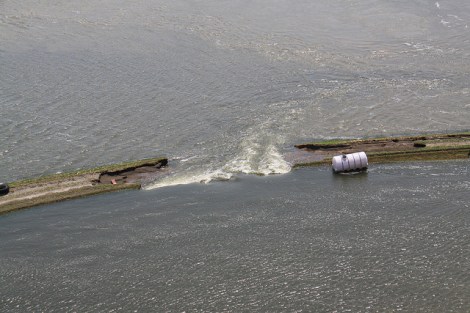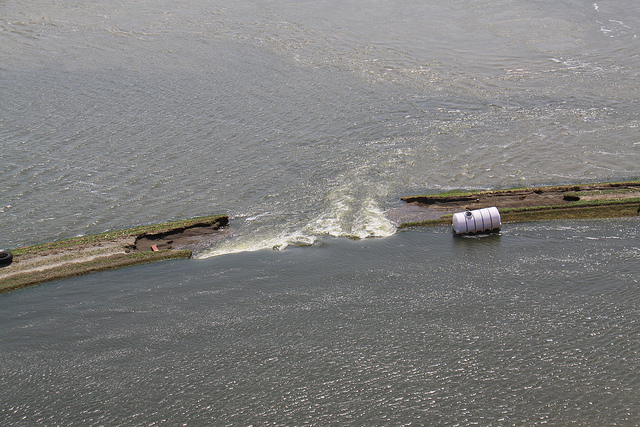One source of contention during the House’s aggrieved, extensive debate over providing aid to Hurricane Sandy victims was how much money should be spent on preventative measures. To what extent, that is, should the government spend money now in order to save money in the future — spend money bolstering coastlines in New York and New Jersey so that the next time a big storm comes through, damage is less severe. The preferred answer of the House Republican majority was: zero dollars.

usacehqAn intentional levee breach in Iowa.
The GOP’s refusal to spend on prevention is looking all the more shortsighted in light of a new assessment by the Army Corps of Engineers of the strength of the nation’s levees. What the Corps is finding is not encouraging, raising the specter of another massive infrastructural need. From the Associated Press:
The U.S. Army Corps of Engineers has yet to issue ratings for a little more than 40 percent of the 2,487 structures, which protect about 10 million people. Of those it has rated, however, 326 levees covering more than 2,000 miles were found in urgent need of repair.
The problems are myriad: earthen walls weakened by trees, shrubs and burrowing animal holes; houses built dangerously close to or even on top of levees; decayed pipes and pumping stations.
How big is the risk? Hard to say.
The Associated Press requested, under the Freedom of Information Act, details on why certain levees were judged unacceptable and how many people would be affected in a flood. The Corps declined on grounds that such information could heighten risks of terrorism and sabotage.
It’s up to local governments to maintain levees, just as it’s up to each of us to go to the dentist. It’s costly, it takes time, and if there’s no immediate problem, it’s easy to postpone. The longer you go without maintenance, though, the bigger the problems that result.
One would think that — following 2005 when all of New Orleans’ teeth fell out and its wisdom teeth were all impacted and so on — communities would be eager to figure out how to prevent the same thing from happening to them. Not so.
Some local officials say that the Corps is exaggerating the dangers, that some deficiencies were approved or not objected to by the federal government and that any repairs could cost them hundreds of thousands, if not millions, of dollars.
“It’s just not right to tell a little town like this to spend millions of dollars that we can’t raise,” said Judy Askew, mayor of Brookport, a hardscrabble town of about 1,000 on the banks of the Ohio River.
If the Ohio floods and the levee fails, someone will pay to restore Brookport — at a price tag almost certainly greater than those millions Askew doesn’t have. And these areas are very likely to flood, if the federal government’s draft climate change report is any indicator.
As we’ve noted before, government has a bias toward funding relief and an antipathy to funding prevention. A lot of this is politics; there’s much more political will to help those left homeless than there is to raise money to protect the home in the first place. It’s why each of the people who spoke out against Sandy aid were very deliberate in articulating how far their hearts went out to victims, even as they pushed measures that would ensure there’d be more victims in the future.
In the meantime:
As of Jan. 10, the agency had rated 1,451, or 58 percent, of [the nation’s levees]. Of those, 326 were unacceptable, 1,004 were minimally acceptable with deficiencies that need correcting, and 121 were acceptable. …
A number of local managers blame their “unacceptable” ratings on the Corps taking a harder line on compliance with levee construction, operation and maintenance standards.
“Since Katrina, they’re almost hyper-vigilant,” said John Sachi, city engineer for South St. Paul. “It’s almost like they’re remedying their mistakes from the past by putting the onus on us to make sure things get better.”
That’s almost exactly what it’s like.



